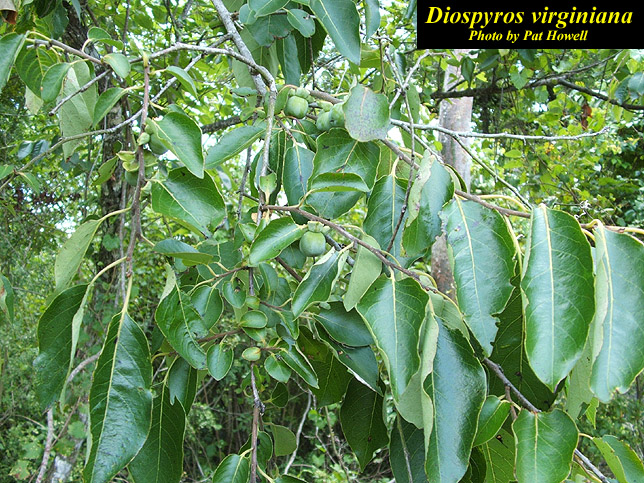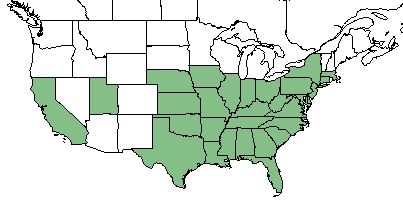Difference between revisions of "Diospyros virginiana"
(→Ecology) |
(→Conservation and Management) |
||
| Line 53: | Line 53: | ||
==Conservation and Management== | ==Conservation and Management== | ||
| + | ''D. virginiana'' is listed as a species for special concern by the Connecticut Department of Environmental Protection, and it is listed as endangered by the New York Department of Environmental Conservation, Division of Land and Forests.<ref name= "USDA"/> | ||
==Cultivation and restoration== | ==Cultivation and restoration== | ||
Revision as of 13:03, 3 May 2019
Common Names: common persimmon[1]; American persimmon; possumwood
| Diospyros virginiana | |
|---|---|

| |
| Photo by the Atlas of Florida Plants Database | |
| Scientific classification | |
| Kingdom: | Plantae |
| Division: | Magnoliophyta - Flowering plants |
| Class: | Magnoliopsida - Dicots |
| Order: | Ebenales |
| Family: | Ebenaceae |
| Genus: | Diospyros |
| Species: | D. virginiana |
| Binomial name | |
| Diospyros virginiana L. | |

| |
| Natural range of Diospyros virginiana from USDA NRCS Plants Database. | |
Contents
Taxonomic Notes
Synonyms: D. virginiana L. var. pubescens (Pursh), D. virginiana L. var. platycarpa (Sargent), D. mosieri (Small)
Description
D. virginiana is a perennial tree of the Ebenaceae family native to North America. [1] East from the Mississippi River, D. virginiana has cuneate to rounded leaves at the base that are glabrous or glabrescent, while D. virginiana west of the Mississippi River have subcordate leaves that are persistently pubescent. These differences could be worthy of varietal recognition.[2]
Distribution
D. virginiana is found throughout the east coast and southeastern United States as well as California and Nevada. [1]
Ecology
Habitat
D. virginiana is easily adaptable to a variety of habitats. It is found in rocky hillsides, sandy woodlands, and even river bottoms. It prefers, terraces of streams and river bottoms that have clay in the soil. It prefers full sun but can tolerate shade. [1]
D. virginiana is considered one of the most common mid-story vegetation in the Upper Panhandle Savanna. [3]
A variety of habitats have been visited for samples of D. virginiana including mixed woodlands, pine wiregrass community, lowland woodlands, old field, dry sandy soils, edge of branch swamp, and sandy ridge near swamp. [4]
Phenology
General flowering time of D. virginiana is from May to June with fruiting occurring between September and December and persisting.[2] It has been observed flowering in April and May as well.[5]
Seed dispersal
This species is thought to be dispersed by consumption by vertebrates. [6]
Fire ecology
Prescribed burns can be used to control the species, but fire exclusion can decrease its likelihood of surviving. [1]
Pollination
This plant is dioecious, meaning that male and female plants are separate individuals.[2]
Use by animals
Bess use the nectar from the flowers for honey. White-tailed deer eat the twigs and leaves. The fruit of the tree is eaten by squirrel, fox, skunk, deer, bear, coyote, racoon, opossum, quail, wild turkey, catbird, cedar waxwing and other various birds.[1] It is an edible fruit for humans as well, known for being sweet yet can be bitter if the fruit is not fully ripe.[2]
Conservation and Management
D. virginiana is listed as a species for special concern by the Connecticut Department of Environmental Protection, and it is listed as endangered by the New York Department of Environmental Conservation, Division of Land and Forests.[1]
Cultivation and restoration
Photo Gallery
References and notes
- ↑ 1.0 1.1 1.2 1.3 1.4 1.5 1.6 USDA Plant Database
- ↑ 2.0 2.1 2.2 2.3 Weakley, A. S. (2015). Flora of the Southern and Mid-Atlantic States. Chapel Hill, NC, University of North Carolina Herbarium.
- ↑ Carr, S. C., et al. (2010). "A Vegetation Classification of Fire-Dependent Pinelands of Florida." Castanea 75(2): 153-189.
- ↑ URL: http://herbarium.bio.fsu.edu. Last accessed: June 2018. Collectors: R.K. Godfrey, Cecil Slaughter, Loran Anderson, T.Lott, B. Lund, Tom Barnes, Richard Mitchel, Gary Knight, Patricia Elliot, Bruce Hansen, Anne Perkins, Gwynn Ramsey, Karen MacClendon, M. Boothe, Leon Neel, Richard Gaskalla, R. Komarek, A. Johnson, M, Jenkins, Richard Carter. States and counties: Florida (Marion, Massau, Liberty, Franklin, Leon, Alachua, Wakulla, Highlands, Hernando, Jackson, Taylor, Collier, Lee, Sarasota, Gadsden, Suwannee, Calhoun, Washington, Holmes, Gulf) Georgia (Thomas, Grady, Lee)
- ↑ Nelson, G. PanFlora: Plant data for the eastern United States with emphasis on the Southeastern Coastal Plains, Florida, and the Florida Panhandle. www.gilnelson.com/PanFlora/ Accessed: 21 MAY 2018
- ↑ Kirkman, L. Katherine. Unpublished database of seed dispersal mode of plants found in Coastal Plain longleaf pine-grasslands of the Jones Ecological Research Center, Georgia.